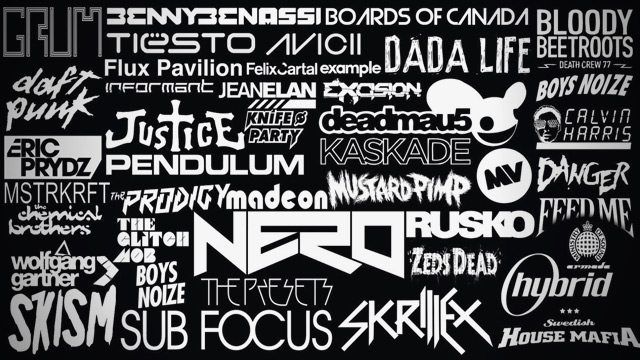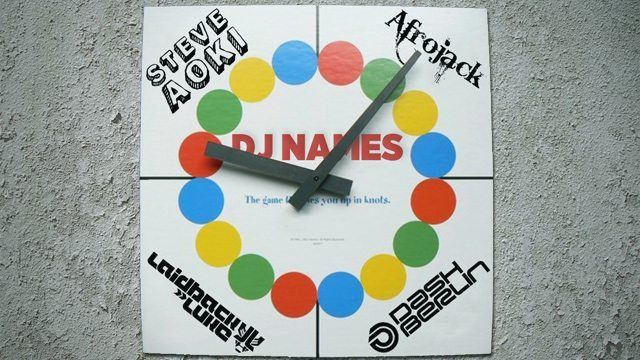More than just a name, the title associated with your DJ or producer performances can set the tone, create ideas about your style or the experience of hearing you perform, and help fans remember you down the line. Today we’re taking another look at how names work and fail within our industry, as well as what patterns and science you can use help make yours a success.
BEING MEMORABLE
We’ve all known some great DJs that never see the limelight. Despite strong efforts, they just can’t seem to get a viral grip on the young party people. Ultimately, a DJ’s (or producer’s) success is based on how many people are talking about, sharing, and spreading your music. If people can’t remember what to call you, or what you sound like, they most likely won’t be telling anyone to check you out.
Alternately, if your name is really easy to remember, it will most likely come up in a lot more conversations. But more important than being easy to remember is the science of being memorable. For example, the name “DJ Beat” is easy to remember, but easily gets lost due to its generic vibe, but “DJ Beat Off” is memorable, albeit crass. One is milk-toast, the other causes a stir (for the record, I don’t endorse/enjoy either of those names). Certain names just beg to be talked about. What is its exactly that makes something memorable, easy to remember, fun-sounding, and cool?
NAMES CREATE MEANING
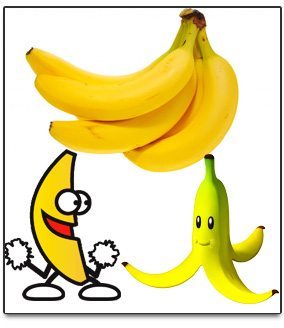 When thinking about words, most humans have internal visualizations of them.
When thinking about words, most humans have internal visualizations of them.
For example, when you encounter the word “banana”, perhaps an image of a yellow fruit appears in your mind’s eye and you remember everything you have ever associated with banana, perhaps a monkey, or Mario Kart, or a memory of that one time you wore a banana costume to a music festival. Suffice to say there’s a lot of questions when it comes to a name: Is it easy to remember? Is it memorable? Does it sound fun? Does it conjure a distinct visual element? Does it make you want to tell someone about it?
I began my hunt by looking for patterns in successful DJ names. What makes them special? Why has my 12-year-old brother heard of Skrillex? Why is my mom asking me if I’ve heard of Deadmau5?
In order to understand and analyze what makes a good DJ name, I’m going to get a bit geeky and scientific. But the bottom line is that all technicalities aside, a good name should sound like a fun event to go to, keyword to Google, or just to generally remember. Particularly in a world of a thousand bands where “everyone wants to be a producer,” you will need to be very calculating in order to peg yourself into people’s memories. There are a variety of techniques for achieving this.
THE PATTERN: COMPOUND NAMES
The first, and most validated pattern in successful DJ names is a compound name – a two-syllable or two word name. The pattern (which of course can be broken!), uses two syllables or “beats”. The first word is an attitude-oriented spin, the second word is typically an icon or symbol that people can relate to and already have ideas about, or that brings imagery to mind.
Why this pattern? The purpose here is to latch on to some idea or concept that people are already well familiar with and put an unexpected twist on it that causes a thought-provoking or emotion-evoking response.
Before we look at some real life examples, let’s use a hypothetical, extreme, and mildly offensive demonstration name that I’ve just made up to show how this compound naming scheme works so well:
That’s right, Crack Nun. I expect to see them on the Coachella lineup next year.
So first you’re going to think of all the lovely, harmless nuns you’ve ever known – every movie with a nun, perhaps some vague childhood memories of going to church, and so on. But then: crack? Is she smoking it? Suddenly you’re picturing a nun smoking crack!
Imagine how easily this name could rise to public popular awareness – next thing you know Crack Nun is being discussed on conservative television and your grandma is calling you asking you if you’ve heard of this atrocity. Teens, loving the rush of endorphins they get whenever they talk about “Crack Nun” begin spending all their allowances on your overpriced shows, and college students create internet memes and pioneer the movement, proudly wearing Crack Nun merch. Boom, household name.
But of course Crack Nun is a terrible example so let’s look at some real life DJ names that use this technique.
REAL LIFE EXAMPLES + ANALYSIS
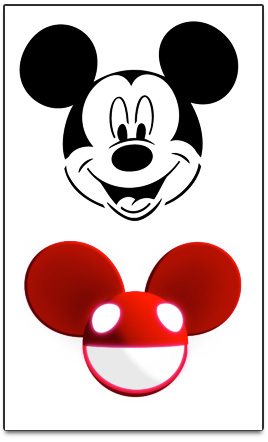 DeadMau5 (dead – mouse): The name originally came from a dead mouse Joel Zimmerman found in his computer, there may be another reason why this name sticks. Here we take one of the most iconic characters of the 20th century (Mickey Mouse), kill him, and send him to a rave. You can’t get any closer to a total loss of innocence and devilish iconography. This is a brilliant name because nearly everyone knows about Mickey Mouse – and can also draw him. Suddenly everyone, from a grandma to a middle schooler (and everyone in between) can identify, draw, and remember Deadmau5.
DeadMau5 (dead – mouse): The name originally came from a dead mouse Joel Zimmerman found in his computer, there may be another reason why this name sticks. Here we take one of the most iconic characters of the 20th century (Mickey Mouse), kill him, and send him to a rave. You can’t get any closer to a total loss of innocence and devilish iconography. This is a brilliant name because nearly everyone knows about Mickey Mouse – and can also draw him. Suddenly everyone, from a grandma to a middle schooler (and everyone in between) can identify, draw, and remember Deadmau5.
Diplo (dip – lo): Here we combine a unambiguously sexy term “low” as in “get low,” “low down,” and add the additional swagger factor of dipping. The term “dip” is usually only used by very cool members of society to communicate they will be leaving shortly. It implies a carefree ambivalence, which is a typical attitude of cool people.
A-Trak (a – track): We all know DJs play tracks, but do they play the “A” tracks? This name adds a classic, choice, and prime vibe to the well known word, track. Simple and classic, don’t try too hard.
Skrillex (skrill – x): Gangsta or slang term for money (skrilla!) meets straight edge emo kid. The resulting image is one of 50 Cent infiltrating Hot Topic with a lazer gat.
Ill Gates (ill – gates): Of course, the whole family knows about Bill Gates. So when Bill turns Ill someone’s sure to take notice and tell a friend. “Did you hear about Ill Gates??” This is an increasingly popular style of taking a familiar proper noun and reversing or modifying it very slightly (Mord Fustang is another great example).
Bassnectar (bass – nectar): Brilliant imagery of dripping bass. This name clearly states its two intentions: to load you up with bass, and melt your brain till it drips, like nectar.
Flosstradamus (floss – tradamus): This one is longer in syllables, but still has a compound word framing – the freshness of dental floss with the prophetic ramblings of an ancient seer. Take a traditional recognizable name and put very modern word on it!
THE SCIENCE BEHIND COMPOUND NAMES
The two word name pattern in the examples above is important from a psychological perspective because it taps into a pre-encoded memory stream. By piggybacking on a memory that people already have (and share with much of the rest of the world), you can secure a place in the collective conscious that will already be deeply ingrained.
I’m not making this up – in fact, the two word/syllable model is such an important part of early human development and thought that there is even a psychological term for it:
Telegraphic speech,“is speech during the two-word stage of language acquisition in children, which is laconic and efficient. Researchers have noted that this period of language acquisition occurs some time between the ages of 18–36 months and is present not just in English-speaking cultures, but can be found worldwide.” – Wikipedia
In layman’s terms, the two-word name is balanced and short. This means that by using a two word name, not only will you be tapping into one of our most primitive and early adopted speech patterns, but one that is shared around the world, across all cultures and languages. It is the single most efficient way to communicate a big idea, and can be used to great effect.

Of course you are, based on analytic data from users of this site, you are probably (but not definitely) a male between the ages of 14 and 35. Which puts you in a position of great potential inebriation. According to a scientist, drinking alcohol (a common and arguably critical element of partying, dancefloors, and DJ culture) breaks down frontal lobe functionality, reducing the drunk person to a more simple state of cognition. The frontal lobe is the part of your brain that controls impulses, judgment, language production, and working memory.

When the frontal lobe of the brain is inhibited, as by alcohol, even the most responsible adults will revert to telegraphic speech patterns. According to Wikipedia, “regression to telegraphic speech may indicate a neurological problem such as multiple sclerosis… or other damage to the posterior-inferior frontal lobe.”
As a result, drinking, and a party environment will best be remembered and communicated with a speech pattern in line with the same type of telegraphic speech used by small babies. In a study by Bryn Mawr University, it was determined that “individuals who consume alcohol can show impulsive and reckless behavior similar to those with frontal lobe damage.”
Semantic Relations
Further insight into successful DJ names can be derived from studying the way infants string together their two word sentences. In a 1973 study, psychologists were able to distinguish that, “75% of children’s two-word utterances could be summarised in the existence of 11 semantic relations:
Eleven important early semantic relations and examples based on Brown 1973:
- Attributive: ‘big house’
- Agent-Action: ‘Daddy hit’
- Action-Object: ‘hit ball’
- Agent-Object: ‘Daddy ball’
- Nominative: ‘that ball’
- Demonstrative: ‘there ball’
- Recurrence: ‘more ball’
- non-existence: ‘all-gone ball’
- Possessive: ‘Daddy chair’
- Entity + Locative: ‘book table’
- Action + Locative: ‘go store’”
When you’re building your two word name, experiment with these different relationships, brainstorm words that work with your image, and plug them into these semantic relationships. If you can’t help but smile when you say it, you might be onto something.
Compound Themes: The Cute Punk Trend
In additional to creating compound names that imply juxtaposed meaning, a lot of artists see success in creating a theme that memorably aligns two divergent concepts.
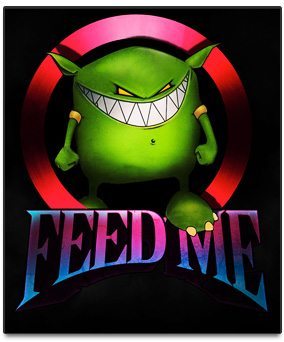 The cute punk trend is one of the most enduring and successful juxtapositions because appeals to both genders (remember, it ain’t no party without the ladies!). The fusion of cute and punk represents a loss of innocence which humans inescapably associate with sex (a rather popular subject amongst the partying crowd). Simultaneously, they are hardwired to be attracted to the cute (read more about the science of cute in this HuffPo article). It is playful and balanced.
The cute punk trend is one of the most enduring and successful juxtapositions because appeals to both genders (remember, it ain’t no party without the ladies!). The fusion of cute and punk represents a loss of innocence which humans inescapably associate with sex (a rather popular subject amongst the partying crowd). Simultaneously, they are hardwired to be attracted to the cute (read more about the science of cute in this HuffPo article). It is playful and balanced.
Let’s look at an example: Feed Me (logo at right). This is a great example of the of cute/punk fusion. Here we have a cute little monster with a grin and body language that say he’s going to kill and eat you. The ladies (and snuggle-forward men) want to pick him up and squeeze him till he giggles, but the grin represents a feisty nature that also gives them a sense of being seduced. The contrast makes the character memorable and fun. The best part is that the name, “Feed me!” totally plays into the cute baby-like appearance, while also suggesting a unique appetite for blood, evil, or sex. You can picture him saying “feed me!” in a little monster voice.
When your mind can easily start to make up a story about the artist or brand without ever even hearing the music, you know you’re onto something.
IN-CONCLUSION
That’s definitely enough theory and speculation, now it’s time to start drafting up some ideas. Unfortunately, the more I dial in the exact formula for creating the ultimate name, the harder for me it is to come up with one. A good strategy is to make a list of icons or symbols that could work, look for anything that is already in the public consciousness. Do your best to find one syllable words.
It might help to start with a character or image, and then try to describe the image with your name. This ensures that you’ll be creating the proper synergy between you visuallly and your name. In other words, the name should describe the character, so sometimes you’ll want to start with the character. But when you’re creating the character, of course, you’ll want to consider your audience:
HOW TO TEST YOUR NAME

Too often I hear my friends coming up with names that sound painful, technical, or downright off putting. Remember, you should be crafting this brand based on what output you want and what genre you’re looking to rule. Do you really want to play to a dark room full of sweaty men on ketamine, or would you prefer a more gender-balanced party? If the latter, then proceed, if the former, pick a name like “Circuit Rage.”
The name should also feel right for the style of music you plan on releasing and mixing. For example, “Death Bro” doesn’t really work for a house artist, although it might be great for a dubstep artist.
Whenever you come up with a new name idea, don’t just ask your close friends, go out into the world and ask your target audience (attractive women? swing dancers? free jazz aficionados?) if they would want to go to a ______ show, or if they’ve heard of ______, or even if they think it sounds cool and interesting. By judging their interest in the subject, and willingness to investigate, you can deduce if your name has the right kind of viral potential.
BREAK THE RULES!
Remember, you don’t have to follow these rules to make a great name. There are boundless examples that refute the compound name theory, however the patterns remain, leaving it a clear and rapid route to becoming a household name.
Agree? Disagree? Want to share your own speculation on what makes certain names really stick in the DJ/producer world? Let’s chat in the comments.


